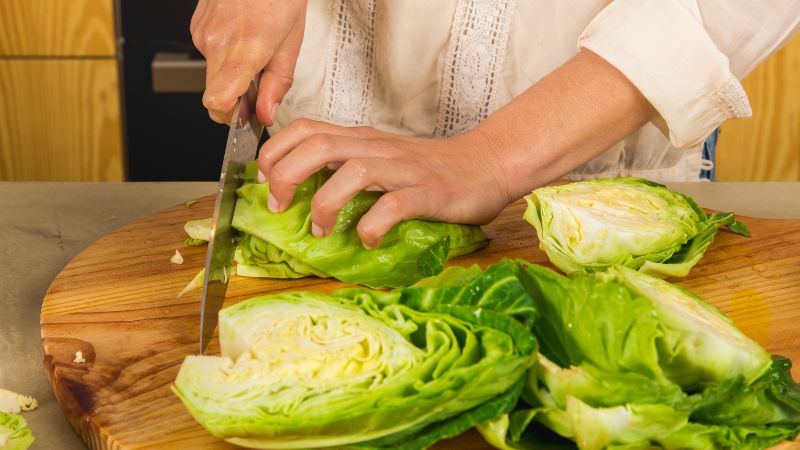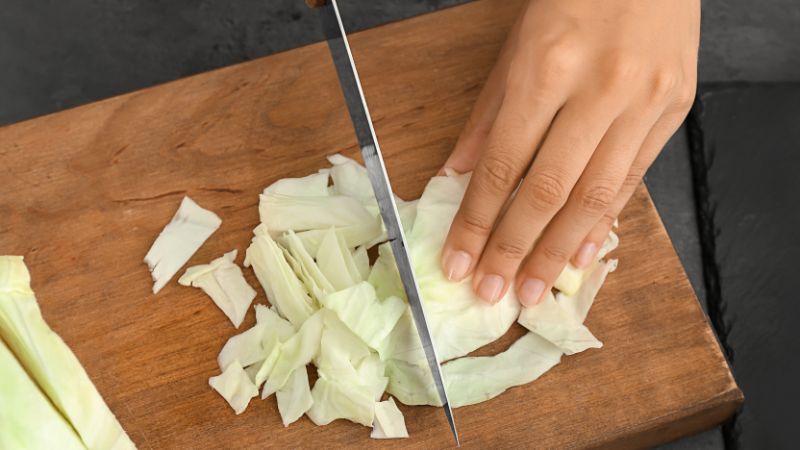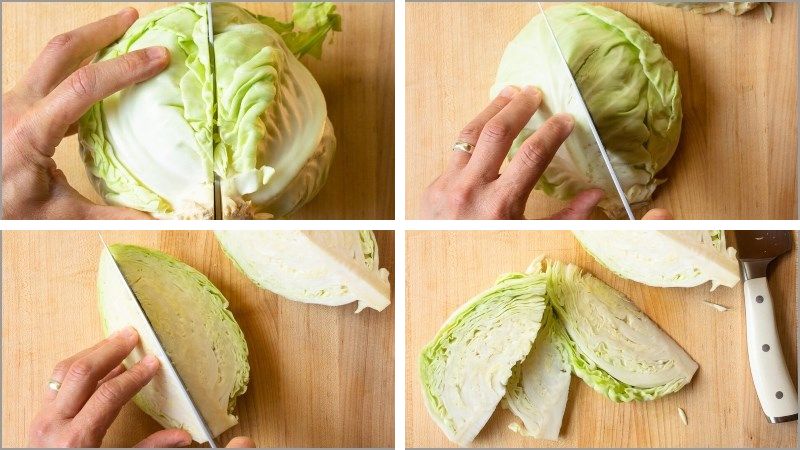Cabbage is a familiar ingredient in Vietnamese family meals. However, not everyone knows how to cut cabbage correctly to make the dish more delicious and attractive. In this article, we will guide you through 3 basic ways to cut cabbage used by professional chefs, helping you easily cook delicious cabbage dishes.
1. How to Cut Cabbage into Long Strips
Cutting Cabbage with a Knife
 Cutting cabbage with a knife
Cutting cabbage with a knife
Cutting cabbage into strips is a basic cooking skill, but not everyone knows how to do it properly. Here is a detailed guide to help you easily cut cabbage with a knife:
First, remove 1-2 outer layers of wilted or bruised cabbage leaves. Then, use a sharp knife to cut off the cabbage’s stem.
Next, place the cabbage on a cutting board and cut it lengthwise into 4 equal parts. Remove the hard core from each section.
Hold each section firmly and use a knife to cut it into thin strips as desired. The length and thickness of the cabbage strips can be adjusted according to your preference and the dish you are preparing.
Cutting Cabbage with a Mandoline
 Cutting cabbage with a mandoline
Cutting cabbage with a mandoline
In addition to using a regular knife, you can quickly and conveniently cut cabbage into long strips using a mandoline.
First, cut the cabbage in half lengthwise. For easier handling, you can continue to cut the cabbage into quarters (or more, depending on your desired size).
Then, use a knife to cut off the hard core, and then use the mandoline to slice the cabbage. Or, use a specialized mandoline for cabbage; place the cabbage on the mandoline and slide it sideways to shred it into strips.
2. How to Cut Cabbage into Square Pieces
 Cutting cabbage into square pieces
Cutting cabbage into square pieces
In addition to the usual way of cutting cabbage into strips, you can cut it into square pieces to make your dish look more attractive and professional.
Follow the previous methods to remove the outer damaged or bruised leaves. Then, use a sharp knife to cut the cabbage into 4 lengthwise sections.
Continue by cutting off the hard core and turning the cabbage over, cutting it into 3-4 sections crosswise according to your desired size. Finally, turn the cabbage sections sideways and cut them into square pieces of your desired size.
3. How to Cut Cabbage into Wedges
 Cutting cabbage into wedges
Cutting cabbage into wedges
Instead of the traditional methods of cutting cabbage, challenge yourself with this unique wedge-cutting technique. With just a few simple steps, you can transform this familiar ingredient into new and creative shapes.
First, cut the cabbage into 4 lengthwise sections, keeping the core intact. Then, place the cut side of the cabbage sections down on the cutting board. Finally, use a sharp knife to carefully cut diagonally from the outer edge to the core, creating attractive wedge shapes.
4. How to Store Cabbage
 Storing cabbage
Storing cabbage
-
When cutting cabbage, use a sharp knife to avoid applying too much force and cutting too deeply into the cabbage, which can cause bruising.
-
For the remaining unused cabbage, wrap it tightly in plastic wrap to protect it from air and oxidation.
-
For cut cabbage, place it in a clean container and store it in the refrigerator crisper drawer. This way, the cabbage can be stored for 2 to 7 days.
With these 3 simple ways of cutting cabbage, you can easily cook delicious cabbage dishes. Apply these tips to make your meals more appealing and attractive!
































